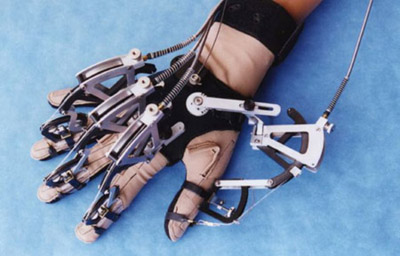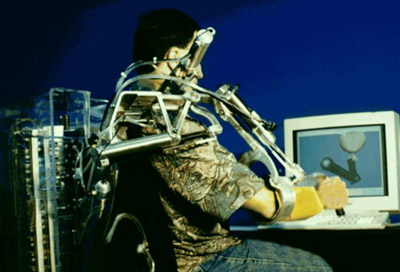

|
A Robotic Teacher of Chinese Handwriting |
| Haptics (pronounced HAP-tiks) is the science of applying touch (tactile) sensation and control to interaction with computer applications. (The word is derived from the Greek word haptein meaning "to fasten"). By using special input/output devices (joysticks, data gloves etc), users can receive feedback from computer applications in the form of felt sensations in the hand or other parts of the body. Combined with a visual display, haptics technology can be used to train people for tasks requiring hand-eye coordination, such as surgery and space ship manoeuvres. It can also be used for games in which you feel as well as see your interactions with images. For example, you might play tennis with another computer user somewhere else in the world. Both of you can see the moving ball and, using the haptic device, position and swing your tennis racket and feel the impact of the ball. |
|
|
|
| Photo source: Haptic Photo Gallery |
| In Chinese handwriting, the movement is as important as the graphical result. This project aims at aiding children as well as people who are not familiar with Chinese learn the strokes of the handwriting. By using a Delta Haptic Device coupled with a display system as a visual interface, the aim of this project can be realised. |
| First, a human teacher writes a character and stores it in the database of the programme. A student only needs to retrieve the file from the database, click on the appropriate icons and start learning. By sending feedback forces to the structures of the Delta Haptic Device, the studentís hand can be guided onto the right track if he/she veers from the standard as set by the teacher. |
| Potential advantages of the Virtual Teaching System are:
1. There is no longer a need for a teacher to be physically present when a student wishes to learn Chinese handwriting. Since all data is recorded in the database in the computer, the student has the flexibility to choose when he wants to learn. 2. The student can select a variety of settings and learn at his/her own pace. This is similar to individual tuition with attention given to the student needs. |
|
Overview of Robotic Teacher |
|
Photo of Stylus Attachment |
|
Screen Shot of GUI |
|
Reference |
|